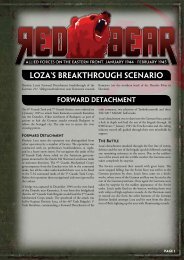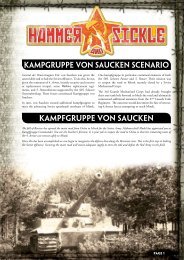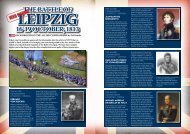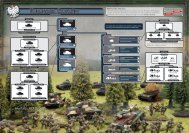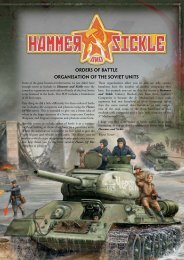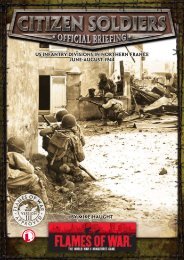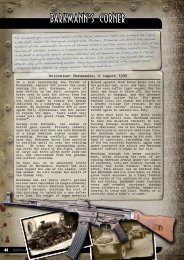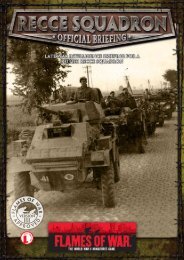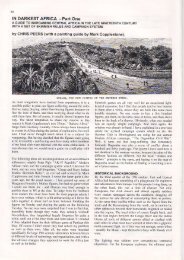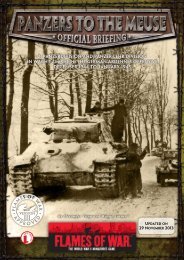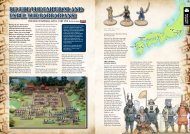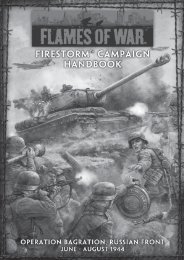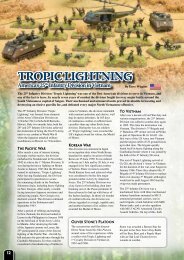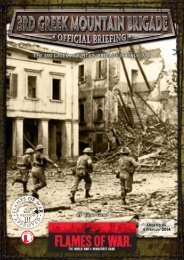Hungarian Infantry (PDF)... - Flames of War
Hungarian Infantry (PDF)... - Flames of War
Hungarian Infantry (PDF)... - Flames of War
Create successful ePaper yourself
Turn your PDF publications into a flip-book with our unique Google optimized e-Paper software.
By Wayne Turner
Defensive Lines<br />
Axis Moves<br />
Soviet Advance<br />
Mountain Pass<br />
<strong>Hungarian</strong> <strong>Infantry</strong> Forces in 1944<br />
After their experience on the Don River in the winter <strong>of</strong><br />
1942/43 the <strong>Hungarian</strong>s instituted a number <strong>of</strong> changes to<br />
their infantry forces in 1943. The first <strong>of</strong> these reforms was<br />
known as the Szabolcs I plan and was updated in early 1944<br />
to the Szabolcs II plan. The new infantry divisions were based<br />
around three 3-battalion infantry regiments (the forces on the<br />
Don were two regiment light divisions). They were upgraded<br />
with heavier artillery, replacing the old 80mm field guns with<br />
100mm howitzers and reinforced by 149mm howitzers. An<br />
effort was made to obtain heavier anti-tank weapons such<br />
as the 75mm PaK40 from the Germans and each infantry<br />
regiment was issued with nine <strong>of</strong> these. Another lesson learned<br />
from the Germans was the need for the infantry to have their<br />
own armour and the Assault Artillery was formed with the<br />
intention to have a battalion <strong>of</strong> Zrínyi assault howitzers available<br />
to each infantry division.<br />
As war continued to push closer the <strong>Hungarian</strong> border, provisions<br />
were made for mobilising more forces in the form <strong>of</strong><br />
Reserve or Replacement divisions. These were formed along<br />
the same organisation as the first line divisions, but usually<br />
had less artillery available, with just three instead <strong>of</strong> four battalions,<br />
and no assault artillery battalion.<br />
The other infantry forces the <strong>Hungarian</strong> had at hand for home<br />
defence were the various border troops. These included the<br />
Border Guard, Border Police, Mountain Border Police and the<br />
traditional border levy <strong>of</strong> the Székler Command. The Border<br />
Police were part <strong>of</strong> the Ministry <strong>of</strong> the Interior and their roles<br />
included customs and excise, and immigration control, but<br />
in times <strong>of</strong> war they could be mobilised to defend the border.<br />
The Mountain Border Police were mobilised in times <strong>of</strong> war<br />
The BaTTle For<br />
hungary 1944<br />
N<br />
Székesfehérvár<br />
Lake Balaton<br />
1 December<br />
Pécs<br />
Esztergom<br />
Vál<br />
Ipolyság<br />
BUDAPEST<br />
Lake Velence<br />
3 rd <strong>Hungarian</strong><br />
Army.<br />
R. Danube<br />
Mohács<br />
2 nd Panzer<br />
Börzsöny<br />
Hills<br />
Hatvan<br />
6 th Army<br />
Kicskemét<br />
R. Tisza<br />
1 st Panzer<br />
Army<br />
Army<br />
Group<br />
South<br />
1-13 October<br />
to provide the two <strong>Hungarian</strong> Mountain Brigades and new<br />
Border Guard units were raised to replace them. The Border<br />
Guard came under the Army and also patrolled the borders<br />
in peacetime, but they also provided fortress companies for<br />
the guarding <strong>of</strong> strategic passes and fought if Hungary was<br />
invaded.<br />
The Székler Command has it roots in the traditions <strong>of</strong> the<br />
Austro-<strong>Hungarian</strong> empire, which had a tradition <strong>of</strong> keeping<br />
irregular light border troops to harass any invading enemy<br />
(usually the Ottoman Turks). The Székely are the ethnic<br />
<strong>Hungarian</strong> people <strong>of</strong> Transylvania. During World <strong>War</strong> II their<br />
responsibility was the Székel Corner, the part <strong>of</strong> Hungary<br />
known as Northern Transylvania that jutted out over the<br />
Romanian controlled territory <strong>of</strong> the rest <strong>of</strong> Transylvania.<br />
Because <strong>of</strong> the way Transylvania was divided in 1940 the<br />
border had no natural features on which to anchor the border<br />
defence and defence in this sector became a difficult prospect.<br />
It had only been linked by rail to the rest <strong>of</strong> Hungary in 1942.<br />
The Székler Command was made up <strong>of</strong> a mix civilian Border<br />
Police, army Border Guard and local militias whose responsibilities<br />
included the defence <strong>of</strong> any passes and roads navigable<br />
by enemy tanks in the Carpathian Mountains. Because <strong>of</strong> its<br />
isolated position the Székel Corner was supplied with ammunition<br />
and provisions for four weeks fighting in case it was<br />
cut-<strong>of</strong>f, as well as food stockpiles for the civilian population.<br />
Fighting For the Székel Corner<br />
The Romanians changed sides after their defeat by the Soviets<br />
in the battles for Iaşi and Chişinău in August 1944 and the<br />
threat <strong>of</strong> invasion became an imminent reality. As early as<br />
8 th Army<br />
Second<br />
Ukrainian<br />
Front<br />
R. Maros<br />
Transylvania<br />
Debrecen<br />
1 st <strong>Hungarian</strong><br />
Army.<br />
2 nd<br />
<strong>Hungarian</strong><br />
Army.<br />
Third<br />
Ukrainian<br />
Front<br />
Carpathian Mountains<br />
Kolozsvár<br />
Vulcan<br />
Pass<br />
Torda<br />
13 October<br />
Dés<br />
Ratosnya<br />
Fourth<br />
Ukrainian<br />
Front<br />
Nagyszeben<br />
Red Tower<br />
Pass<br />
8 th Army<br />
1 October<br />
Székel Corner<br />
Carpathian Mountains<br />
0 Miles<br />
0 KM<br />
Beszterce<br />
Marosvásárhely<br />
Vatra Dornei<br />
Tölgyesi Pass<br />
Békás Pass<br />
Tatros Valley<br />
Katrosa<br />
Brassó<br />
100<br />
100 200
10 August Lieutenant-General vitéz (meaning brave, an honourary<br />
title somewhat like a knighthood) Lojos Veress, commander<br />
<strong>of</strong> the <strong>Hungarian</strong> Second Army, with the IX Corps<br />
at Kolozsvári (Cluj) in Northern Transylvania, held a meeting<br />
with his senior commanders and German Generalmajor von<br />
Grolman, the chief <strong>of</strong> staff <strong>of</strong> Army Group South Ukraine,<br />
to discuss the defence <strong>of</strong> the Eastern Carpathians. The<br />
original defensive plan had been made with Romania still<br />
allied with the Germans, but new provisions had to be made<br />
with the threat <strong>of</strong> the Romanians attacking from Southern<br />
Transylvania.<br />
With the collapse <strong>of</strong> the Romanians on the Iaşi/Chişinău<br />
front Army Group South Ukraine had effectively lost five<br />
corps and 18 divisions while they retreated through hostile<br />
territory towards Hungary and the western Ukraine. The<br />
front opened up rapidly and Soviet mechanised and cavalry<br />
forces poured through Romania heading for the Carpathian<br />
mountain passes to Transylvania. This left only <strong>Hungarian</strong><br />
troops to secure their border with Romania. Despite their<br />
defeat at the hands <strong>of</strong> the Soviets, the Romanians still had<br />
substantial forces in the field, and while they went about<br />
re-assembling the Third and Fourth Armies, they had many<br />
training and reserve units <strong>of</strong> the First Army watching the<br />
<strong>Hungarian</strong> border in Transylvania in case the <strong>Hungarian</strong>s<br />
decided to strike.<br />
The first Romanian probe into <strong>Hungarian</strong> territory occurred<br />
on 25 August, west <strong>of</strong> the Moras (Mures) River, when a<br />
battle group <strong>of</strong> Romanian infantry crossed the border in the<br />
Keleman (Călimani) Mountains on the northwestern edge <strong>of</strong><br />
the Székel Corner and clashed with the 23 rd Border Guard<br />
Battalion and local Gendarmes (rural police).<br />
A day later more serious fighting broke out when elements<br />
<strong>of</strong> the Soviet 7 th Guards and the 23 rd Tank Corps crossed<br />
the border into the Úz and Csobányos valleys and north<br />
from the Ciuc Mountains, bringing the fighting proper to<br />
<strong>Hungarian</strong> soil for the first time in the war. On 27 August<br />
fighting occurred at Ojtózi, on 28 August at Gyimesi and in<br />
the Tatros Vallery, all in the Eastern Carpathian Mountains.<br />
Some German units had arrived to join the fighting, with<br />
Kampfgruppe Abraham and Kampfgruppe Fessner joining the<br />
defence. However it became clear that the <strong>Hungarian</strong> border<br />
forces were not going to be enough to hold back the might<br />
<strong>of</strong> the Red Army. <strong>Hungarian</strong> units had begun mobilising in<br />
central Hungary with the Second Army mobilising as further<br />
troops were sent to aid the IX Corps fighting in Transylvania.<br />
The VII Corps headquarters was detached from the First<br />
Army, which was fighting on the border with the Ukraine,<br />
and given command <strong>of</strong> the 25 th <strong>Infantry</strong> Division, 20 th<br />
<strong>Infantry</strong> Division and the 2 nd Armoured Division, all veteran<br />
units who had been fighting in the Ukraine since April. The<br />
Second Army was further boosted by troops quickly raised<br />
as part <strong>of</strong> the field replacement army, including the 2 nd Field<br />
Replacement Division.<br />
Retreating German units increasingly joined the fighting<br />
and the 4. Gebirgsdivision was transferred from the north to<br />
join the defence <strong>of</strong> Transylvania. With only border troops<br />
immediately available the Germans played an important role<br />
in the fighting around the Baróti Mountains, at Nyárád and<br />
holding the Maros (Mures) River and Szászrégent (Reghin)<br />
line and at Marosludas (Luduş) up until the beginning <strong>of</strong><br />
October 1944.<br />
The Ojtózi Pass held for several days, but was lost when the<br />
24 th Border Guard Battalion was forced out the southeast<br />
corner <strong>of</strong> the front line, but with the aid <strong>of</strong> German units<br />
they were able to halt the advance until 9 September along<br />
the Ojtózi (Ozsdola) − Berecki (Bereck) − Lemhény (Lemnia)<br />
− Torja (Turia) − Kászonújfalu (Caşinu Nou) line. The 24 th<br />
Border Guard Battalion and 67 th Border Guard Group’s<br />
determined defence played an important role. During these<br />
battles there were outstanding displays <strong>of</strong> fighting by the<br />
<strong>Hungarian</strong> border troops.<br />
Among these should be mentioned the exploits at Ojtózi Farm<br />
by the 24 th Battalion’s 1 st Fortress Company. The Germans and<br />
<strong>Hungarian</strong>s, after a short but fierce battle, were pushed out <strong>of</strong><br />
the southern exit <strong>of</strong> the Pass into the widening Ojtózi Valley,<br />
where the <strong>Hungarian</strong> 24 th Battalion’s 1 st Fortress Company’s<br />
position was built near the village <strong>of</strong> Sósmező (Poiana Sărată).<br />
Sósmező was the first village within the Kingdom <strong>of</strong> Hungary<br />
to be occupied by Soviet troops in 1944. During the fighting<br />
around the village, most <strong>of</strong> the buildings were destroyed<br />
and many civilians lost their lives. Company commander<br />
Lieutenant Sándor Megyery, deputy company commander<br />
Lieutenant Ferenc Kovács, and the platoon commander at<br />
Ojtózi Pass reserve Ensign János Vácz, were all awarded the<br />
<strong>Hungarian</strong> Cross <strong>of</strong> Merit with Swords and Ribbons. At no<br />
other time during the war had three <strong>Hungarian</strong> <strong>of</strong>ficers from<br />
the same company received an honour for the same action.<br />
In another outstanding action reserve Ensign Ferenc Mező<br />
commanded the machine-gun company <strong>of</strong> the 24 th Border<br />
Guard Battalion defending the area between Kászonjakabfalva,<br />
the 1,051 metre Nyir peak, and the village <strong>of</strong> Katrosa on 3<br />
September. During the day his positions repelled several<br />
Soviet infantry and cavalry attacks. Mező took command <strong>of</strong><br />
the last machine-gun after its crew had been lost, and, already<br />
wounded himself, he beat back several more Soviet infantry<br />
assaults. With nothing but resolute determination he held<br />
his position with hand-to-hand fighting all around him. He<br />
died fighting <strong>of</strong>f Soviet infantry, unwilling to retreat. He was<br />
posthumously awarded the Officers Gold Medal for Bravery,<br />
the 17 th <strong>of</strong>ficer to be so awarded during the war.
All along the Transylvanian border similar fighting occurred<br />
at the Úz, Csobányos and Tatros valleys. The <strong>Hungarian</strong>s held<br />
a line through the Csíki Mountains in desperate fighting by<br />
various battle groups through 12 to 14 September. The bulk<br />
<strong>of</strong> the defence was taken up by the 23 rd , 32 nd and 34 th Székely<br />
Border Guard battalions, the fortress companies <strong>of</strong> the Székely<br />
Border Guard battalions, and the German ‘Fessner’ battle<br />
group. Troops began to arrive in Northwest-Hungary in the<br />
form <strong>of</strong> the 3 rd , 16 th and 22 nd Reserve <strong>Infantry</strong> regiments.<br />
The Soviet 50 th Guard Rifle Corps, <strong>of</strong> the 40 th Army, sent<br />
patrols into Hungary on 3 September to the north and<br />
south <strong>of</strong> the Békás (Bicas) pass. They headed north to the<br />
heights at Point 1502 to increase pressure on the hard-pressed<br />
<strong>Hungarian</strong>s. If the Soviets were able to take possession <strong>of</strong> this<br />
commanding elevation, they planned to then take the Békás<br />
and Tölgyesi passes and at the same time the 1078 meters high<br />
pass at Balázsnyakát where the road between Gyergyóbékás<br />
(Bicazu Ardelean) and Gyergyótölgyes (Tulgheş) crossed. The<br />
positions <strong>of</strong> the 1 st Székely Mountain Border Battalion were<br />
supported by the 21 st Mountain Battery with four guns. Also<br />
in the area was the 21 st Border Guards Battalion, which also<br />
had a four-tube mortar platoon and two German mortars and<br />
a German field artillery battery. The key figure in the defence<br />
was the commander <strong>of</strong> the 21 st Mountain Battery, Lieutenant<br />
Vilmos Brambring. The Battery became key to the defence<br />
with good positions that allowed it to fire on the Soviet<br />
assembly areas before their attack. This soon bore fruit, as<br />
the four <strong>Hungarian</strong> mountain guns, along with the German<br />
battery, were able to lay down a curtain <strong>of</strong> fire covering the<br />
front line in the immediate foreground <strong>of</strong> the Tölgyesi pass<br />
and essentially close down the Soviet attack.<br />
Meanwhile, the areas beyond the Tölgyesi Pass action was<br />
also reinforce by the IX Corps. As a consequence a battalion<br />
<strong>of</strong> the 2 nd Field Replacement Division was sent to<br />
Gyergyószentmiklósi and arrived around midnight at the<br />
train station.<br />
The Kelemen Mountains in the east <strong>of</strong> Northern Transylvania<br />
had not yet been threatened, but on 1 September, the<br />
Beszterce 22 nd Border Guard Battalion and two battalions <strong>of</strong><br />
the Kosnánál Székely Border Guards crossed the border by<br />
rail into Vatra Dornei. There, the Germans formed a bridge-<br />
head, based around an important manganese ore mine.<br />
However, all was not well with the Székely border guards.<br />
The Székely Guard was set up in 1942 and organised along<br />
the lines <strong>of</strong> the traditional Habsburg system. These formations<br />
were made up <strong>of</strong> local men, anywhere from teenagers<br />
to men in their late middle age, and could include up to<br />
three generations <strong>of</strong> one family. Training and equipment<br />
was poor and their fighting spirit was low. On 20 August<br />
1944 the Székely border guard battalions entered the fighting.<br />
They suffered from mass desertions during the first days <strong>of</strong><br />
fighting, as the men <strong>of</strong> the battalions first thoughts were to<br />
protect their families from the invading armies. The phenomenon<br />
came as a bitter surprise to both the <strong>Hungarian</strong> and<br />
German command, because the Székely had a reputation for<br />
their fighting spirit during World <strong>War</strong> I, but in little more<br />
than twenty years it had vanished.<br />
Having done all that they could to hold Northern<br />
Transylvania, on 7 September the <strong>Hungarian</strong>s and Germans<br />
began to evacuate the area. Any plans for the capture the<br />
passes <strong>of</strong> the Carpathians before the Soviets could had proved<br />
utterly illusory. The German Sixth and Eighth Armies, and<br />
<strong>Hungarian</strong> Second Army, under the headquarters <strong>of</strong> German<br />
Army Group South Ukraine, withdrew in several phases<br />
due to the space limitations. As a result, by roughly mid-<br />
September a new defensive position was establishment on the<br />
Moras River. The superior firepower <strong>of</strong> German mobile battle<br />
groups was used to cover the withdrawal <strong>of</strong> the marching<br />
infantry columns <strong>of</strong> shattered <strong>Hungarian</strong> frontier units.<br />
From 16 September arriving battalions in good order were<br />
redeployed along the Kelemen and Görgényi mountains and<br />
at the Ratosnyai Gorge on Maros River. During this period<br />
the Germans took operational command <strong>of</strong> all the <strong>Hungarian</strong><br />
units <strong>of</strong> the IX Corps and Székely Border command, for both<br />
tactical and political reasons.<br />
On 12 October 1944 in the area <strong>of</strong> Ratosnya (Răstoliţa) −<br />
Beszterce (Bistriţa) − Dés (Dej) − Szászrégen (Reghin) bordering<br />
Northern Bukovina more heavy fighting took place.<br />
The Székely 27 th Light Division was redirected to halt the<br />
Soviet advance, but they could do little to stop the Soviet<br />
mechanized and armoured force. All the lightly equipped<br />
division could do was delay them.
the Battle For torda<br />
In late August 1944 the <strong>Hungarian</strong> command decided to<br />
make a push towards the Southern Carpathian Mountains<br />
to seize the passes before the Red Army could move through<br />
them. They faced the Romanian First Army, which was made<br />
up <strong>of</strong> a mix <strong>of</strong> units still rebuilding after the campaign in<br />
the Crimea and training units. The Romanians soon added<br />
the reforming Fourth Army to the troops gathering in<br />
Transylvania. The campaign was to be entirely conducted by<br />
<strong>Hungarian</strong> troops with the Germans still withdrawing from<br />
Romania or committed to fighting further north.<br />
The <strong>Hungarian</strong> Second Army, under General Lajos Veress,<br />
was mobilised for the task with the IX and II Corps. While<br />
the IX Corps was to hold Northern Transylvania, it was up<br />
to the II Corps to push south. Initially the II Corps had just<br />
the 7 th and 9 th Field Replacement Divisions, but more experienced<br />
troops were transferred from the north to take part and<br />
the 2 nd Armoured Division and 25 th <strong>Infantry</strong> Division arrived<br />
in early September. The attack was finally launched at dawn<br />
on 5 September 1944. By this stage the <strong>Hungarian</strong> command<br />
had given up on their initial plan to push to the Southern<br />
Carpathian passes and instead simply wanted to establish a<br />
Battle oF tordá<br />
13 to 22 SeptemBer 1944<br />
0 Miles<br />
0 KM<br />
Borrév<br />
Komjátszeg<br />
2 nd Mountain<br />
Reserve Brigade<br />
Aranyos River<br />
2<br />
4 8<br />
Mészkö<br />
Szind<br />
Sinfalva<br />
Pusztacsán<br />
Tordátúr<br />
Soviet 5 th Guards<br />
Tank Corps<br />
Koppánd<br />
Tordá<br />
1 st <strong>Infantry</strong><br />
Regiment<br />
Alsószentmihály<br />
2 nd Armoured<br />
Division<br />
Sósfürdö<br />
Soviet 180 th Rifle<br />
Division<br />
Point 367<br />
more defensible line along the Maros River. Veress decided<br />
to straighten out the salient between Marosvásárhely (Targu<br />
Mures) and Kolozsvár (Cluj-Napoca).<br />
Meanwhile Soviet units <strong>of</strong> the Second Ukrainian Front<br />
moved through Vulcan Pass in the Southern Carpathians<br />
and captured Brassó (Brașov) and Nagyszeben (Sibiu). The<br />
Soviets then intended to capture Kolozsvár (Cluj-Napoca),<br />
and expected little resistance. The Romanians had also been<br />
building up their force in the area and had assembled some<br />
11 divisions, though not all <strong>of</strong> them were up to full strength.<br />
During the first five days <strong>of</strong> the attack the 9 th Field Replacement<br />
Division had advanced along the Kolozsvár-Tordá main road.<br />
To their right units <strong>of</strong> 7 th Field Replacement Division move<br />
down the road from Magyarlóna (Luna de Sus) to Borrév<br />
(Buru) on the Aranyos (Arieş) River. On the left flank in<br />
the area <strong>of</strong> Vasasszentgotthárd (Sucutard) the 2 nd Armoured<br />
Division’s attack moved towards Nagysármás (Sărmaşu) and<br />
surprised the Romanian border guards, who either retreated<br />
or surrendered. The only Romanian resistance encountered<br />
was from the outposts <strong>of</strong> the 20 th <strong>Infantry</strong> Training Division,<br />
but their resistance was weak, and the Romanians soon broke<br />
<strong>of</strong>f.<br />
23. Panzerdivision<br />
Aranyospolyán<br />
Felvinc<br />
25 th <strong>Infantry</strong><br />
Regiment<br />
Aranyosgyéres<br />
Soviet 4 th Guards<br />
Rifle Division<br />
Romanian<br />
Armoured Division<br />
Marosújvár<br />
Maros River<br />
<strong>Hungarian</strong> <strong>Infantry</strong> Lines<br />
Axis counterattacks<br />
Soviet Assaults<br />
Bridgeheads<br />
25th <strong>Infantry</strong><br />
Division<br />
Point 429<br />
62 nd Pioneer<br />
Battalion<br />
Aranyosegerbegy<br />
26 th <strong>Infantry</strong><br />
Regiment<br />
Aranyoslóna<br />
Mezöörke<br />
N
By the evening <strong>of</strong> 5 September the 9 th Field Replacement<br />
Division had taken Tordá and the 3 rd Tank Regiment <strong>of</strong> the<br />
2 nd Armoured Division had reached Marosludas (Luduş). On<br />
the 7 th Field Replacement Division’s line there was little or<br />
no resistance and they took Borrév without a fight. The first<br />
battalions <strong>of</strong> the veteran 25 th <strong>Infantry</strong> Division also joined<br />
the attack at Nagyvárad (Oradea).<br />
On 6 September the German reconnaissance troops observed<br />
Soviet tanks in the area <strong>of</strong> Nagyszeben (Sibiu). General<br />
Veress did not halt his troops, he considered a defeat <strong>of</strong> the<br />
Romanians as good for the soldiers’ morale. The armoured<br />
troops attacking on the left flank reached Dicsőszentmárton<br />
(Târnăveni) on 7 September, in the centre 9 th Field<br />
Replacement Division troops took Marosújvár (Ocna Mureş)<br />
and Felvinc (Unirea), and the 7th Field Replacement Division<br />
stood before Nagyenyed (Aiud). The appearance <strong>of</strong> Soviets<br />
and General Rozin’s Romanian Armoured Division halted<br />
<strong>Hungarian</strong> attacks on 9 September and the <strong>Hungarian</strong> troops<br />
on the Aranyos - Maros line withdrew back to where defence<br />
would be made easier by the terrain, especially at Tordá and<br />
Aranyosegerbegy (Viişoara). This line, which was already held<br />
by three battalions <strong>of</strong> the 25 th <strong>Infantry</strong> Division, was particularly<br />
good for defence with the Maros River running in front<br />
<strong>of</strong> it. It was also protected by north bank <strong>of</strong> the river valley,<br />
which was flanked by steep hills slopes 60 to 80 metres high.<br />
The <strong>Hungarian</strong> attack had taken the Soviet command by<br />
surprise and they decided to reinforce with area with more<br />
troops as well as launching an attack <strong>of</strong> their own towards<br />
Tordá in cooperation with the Romanian Fourth Army. The<br />
<strong>Hungarian</strong>s were able to hold this line against attacks by the<br />
Romanian Fourth and Soviet 27 th Armies for the next few<br />
days. The 25 th <strong>Infantry</strong> Division had started taking up positions<br />
on 12 September, first taking up defensive positions at<br />
the river crossing points before Tordá and Aranyosegerbegy.<br />
Of the division’s nine battalion only three were immediately<br />
available to fight at Tordá, four others were deployed with the<br />
7 th and 9 th Field Replacement Divisions in rearguard actions<br />
while two more were still on route to the front by train and<br />
expected to arrive on 13 September. Another battalion arrived<br />
by foot from the rear the same day.<br />
On 13 September the Soviet 5 th Guards Tank Corps appeared<br />
behind the retreating <strong>Hungarian</strong> troops near Alsószentmihály<br />
(Mihai Viteazu) west <strong>of</strong> Tordá, causing some panic. An ad<br />
hoc defensive battle developed in the evening and into the<br />
next day, with Colonel Géza Böszörményi, commander <strong>of</strong><br />
the 25 th <strong>Infantry</strong> Regiment, holding <strong>of</strong>f the Soviet thrust with<br />
III Battalion/25 th <strong>Infantry</strong> Regiment, 59 th Pioneer Battalion<br />
and the 25 th Heavy Anti-tank Company. By the next day the<br />
<strong>Hungarian</strong>s had knocked out seven Soviet tanks.<br />
In the afternoon the Romanian 20 th <strong>Infantry</strong> Training<br />
Division arrived in the area <strong>of</strong> Aranyospolyán (Poiana) lying<br />
east <strong>of</strong> the city and began to attack through the Szent János<br />
valley in the direction <strong>of</strong> Sósfürdő (the salt baths). The area<br />
was only held by I Battalion/1 st <strong>Infantry</strong> Regiment. After<br />
heavy fighting, in which the battalion’s commander was<br />
killed, the enemy pushed into the east <strong>of</strong> Tordá. The situation<br />
was finally restored with a counterattack by I Battalion/25 th<br />
<strong>Infantry</strong> Regiment.<br />
The Soviet 6 th Guards Tank Army was not only attacking<br />
the left <strong>of</strong> the city on 13 and 14 September, but was also<br />
attempting to out flank to the west <strong>of</strong> the city. By then the<br />
25 th <strong>Infantry</strong> Division had deployed to the right <strong>of</strong> the 2 nd<br />
Mountain Reserve Brigade, and they were able to halt the<br />
Soviet attack launched towards Tordátúr (Tureni). However,<br />
they were only able to stave <strong>of</strong>f the attack at great loss.<br />
They deployed a weak battalion at the most critical points<br />
in small German style blocking groups with high firepower<br />
and anti-tank support. Thus, the encirclement <strong>of</strong> the city was<br />
stopped.<br />
The motorised 75mm anti-tank guns (PaK40) <strong>of</strong> the 25 th Assault<br />
Artillery Battalion’s 1 st Battery, under Captain Vilmos<br />
Vértes, also played an important role in halting the Soviet<br />
armour. The previous two days, while under very heavy<br />
mortar and artillery fire, the battery knocked out three tanks,<br />
a rocket launcher, and a few other weapons, and seven more<br />
Soviets tanks were immobilised. The next day while fighting<br />
<strong>of</strong>f an infantry assault on his gun’s positions Captain Vértes<br />
was killed. He was later awarded Officer’s Gold Medal for<br />
Bravery.<br />
On 15 September the Soviet High Command directed<br />
Marshal Malinovsky to advance on the Kolozsvár (Cluj-<br />
Napoca) – Beszterce (Bistriţa) line, crush the <strong>Hungarian</strong> and
German forces in Transylvania, and then attack in northeasterly<br />
direction and unite in the Carpathian Mountains<br />
with the Fourth Ukrainian Front. The operation’s ultimate<br />
aim was to outflank the German Sixth, Eight and <strong>Hungarian</strong><br />
Second Armies, in short to destroy the entirety <strong>of</strong> German<br />
Army Group South Ukraine. The Battle <strong>of</strong> Tordá quickly<br />
evolved in an effort to prevent this. It would prove to be<br />
one <strong>of</strong> the war’s most successful operations for the Royal<br />
<strong>Hungarian</strong> Army.<br />
On 15 September the Soviets launched the first big attack<br />
on Tordá. This was again in the direction <strong>of</strong> Sósfürdő (the<br />
salt baths), but only after a massive artillery preparation. At<br />
the same time, an overwhelming attack was launched against<br />
the 26 th <strong>Infantry</strong> Regiment’s bridgehead at Aranyosegerbegy.<br />
The 25 th <strong>Infantry</strong> Division commander Major-General László<br />
Hollósy-Kuthy, a brave man with a reputation as a tough<br />
nut, requested support from the II Corps when it became<br />
clear that the weight <strong>of</strong> the enemy attack was north through<br />
Sósfürdő in the direction Tordá. The attack proved too<br />
powerful for the 26 th <strong>Infantry</strong> Regiment to hold the eastern<br />
edge <strong>of</strong> Tordá. However, they managed to slow the attack<br />
before withdrawing.<br />
With the situation becoming critical the 2 nd Armoured<br />
Division counterattacked. The division, positioned northeast<br />
<strong>of</strong> the city, launched a counterattack to the south. However, the<br />
enemy proved stubborn and the attack stalled against strong<br />
resistance. The Soviets and Romanians were able to hold the<br />
plateau stretching to the east <strong>of</strong> the Tordá bridgehead.<br />
On 16 September the 2 nd Armoured Division and the 25 th<br />
<strong>Infantry</strong> Division made preparations for their next counterattack,<br />
aimed south between Sósfürdő and Point 367<br />
to eliminate the enemy bridgehead. The following day, the<br />
counterattack was launched by the 25 th <strong>Infantry</strong> Regiment<br />
supported by a battle group <strong>of</strong> the 2 nd Armoured Division.<br />
They were hit by incredibly heavy enemy artillery and rocket<br />
fire, and their progress was halted before they could reach<br />
their targets.<br />
Another <strong>Hungarian</strong> attack began at 1100 hours on<br />
19 September after a strong and coordinated artillery<br />
preparation. The 25 th <strong>Infantry</strong> Regiment and supporting<br />
10 th Assault Artillery Battalion captured the northern river<br />
embankment, but the 2 nd Armoured Division’s 6 th Motorised<br />
<strong>Infantry</strong> Battalion was blocked before Point 367. Together<br />
they could not eliminate the Soviet bridgehead. The enemy’s<br />
extremely tough resistance was characterised by one particular<br />
Red Army infantry battalion <strong>of</strong> 300 men <strong>of</strong> the Soviet<br />
4 th Guards Rifle Division that was encircled, but kept<br />
fighting. At the end <strong>of</strong> the battle 200 men lay where they had<br />
fought and died. During the day the capable Colonel Geza<br />
Boszormenyi died heroically at the head <strong>of</strong> his troops on the<br />
eastern edge <strong>of</strong> the Tordá cemetery, just a few hundred yards<br />
from the tomb <strong>of</strong> his parents, when he was hit by rocket fire.<br />
However, the tenacious defence <strong>of</strong> the Soviet Guardsmen had<br />
halted the <strong>Hungarian</strong> thrust and the Red Army still held the<br />
bridgehead.<br />
The next few days passed relatively quietly as both sides took<br />
stock <strong>of</strong> the situation. However, heavy artillery fire continued<br />
to be exchanged between both sides. At 0800 hours on 22<br />
September hostilities continued anew. After unprecedented<br />
heavy artillery preparation, in the narrow space between<br />
Sósfürdő and the Szent János Valley, the Soviet 180 th Rifle<br />
Division began an attack, with support from 5 th Guards Tank<br />
Corps’ motorised rifleman and 30 to 40 T-34 tanks. At the<br />
same time east <strong>of</strong> the railway line the Soviet 4 th Guards Rifle<br />
Division attacked with three regiments. On the 4 th Guards<br />
Rifle Division’s eastern flank the Romanian 7 th <strong>Infantry</strong><br />
Division advanced. The attack first struck along the riverbank<br />
northwards, hitting the 2 nd Armoured Division, before the<br />
full force <strong>of</strong> the attack hit the Sósfürdő and Szalonnás area<br />
against the 25 th <strong>Infantry</strong> Division.<br />
The thrust towards Sósfürdő encountered the 10 th Assault<br />
Artillery Battalion’s 1 st Battery with six Zrínyi II assault howitzers<br />
under the command <strong>of</strong> Ensign János Bozsoki. Bozoki’s<br />
battery knocked out 18 T-34 tanks during the day’s fighting
preventing the encirclement <strong>of</strong> Tordá. Later in the day<br />
Bozoki returned to the front line to rescue seriously wounded<br />
comrades and recover damaged assault howitzers. He was<br />
awarded the Officers’ Gold Medal for Bravery.<br />
However, the Soviets also attacked the Tordá bridgehead from<br />
the west where the 1st <strong>Infantry</strong> Regiment and 2 nd Reserve<br />
Mountain Brigade defended the front line. At 1200 hours<br />
to the south the 25 th <strong>Infantry</strong> Division front was virtually<br />
split in two, the gap was only closed by the 3 rd Motorized<br />
<strong>Infantry</strong> Regiment’s counterattack with supporting armour.<br />
In Egerbegyi and the northeastern sector <strong>of</strong> the city the<br />
defence firmly held, but could not hold the key high ground<br />
at Point 429. The I Battalion/25 th <strong>Infantry</strong> Regiment played a<br />
major role in the fighting, during which Major László Siprák<br />
also won the Officers’ Gold Bravery Medal for his leadership.<br />
He was almost always at the head <strong>of</strong> his troops with his rifle<br />
in hand. However, it became clear to the defenders that is<br />
was impossible to hold the city on their own against the overwhelming<br />
numbers the Soviets and Romanian could throw<br />
at them.<br />
On 23 September, at Vaskapu (Iron Gate) and Sósfar in the<br />
east-northeast <strong>of</strong> the city, the German 23. Panzerdivision<br />
arrived with two panzergrenadier regiments and about 65<br />
tanks. The German Panzertruppen attacked at dawn. This<br />
powerful counterattack was on a wide front, but narrowed<br />
when it hit Point 367 where a Soviet bridgehead remained.<br />
During the battle the Germans destroyed five Soviet tanks, a<br />
self-propelled gun, and 37 anti-tank guns. The panzergrenadiers<br />
took 35% losses. The situation was more severe in the<br />
west, where the Soviet 18 th Guard Mechanised Brigade’s tanks<br />
reached Komjátszeg and the Tordá - Kolozsvár road. The<br />
situation was stabilised with the deployment <strong>of</strong> the German<br />
troops in the western sector.<br />
The next few days remained stable around Tordá, with<br />
no heavy attacks by the Soviets. However, the Soviet 18 th<br />
Guards Mechanized Brigade, Romanian mountain troops<br />
and infantry continue to jointly probe in the northwest<br />
to encircle the Komjátszeg and Tordátúr area. The Soviets<br />
moved their focus from the west <strong>of</strong> Tordá on 2 October to<br />
the southeast in front <strong>of</strong> Aranyosegerbegy. They attacked the<br />
German-<strong>Hungarian</strong> line, but four Soviet rifle divisions were<br />
halted south <strong>of</strong> Tordá.<br />
On 4 October repeated Soviet attacks from the west pushed<br />
the front line back east <strong>of</strong> the Tordá - Kolozsvár road. To the<br />
east <strong>of</strong> Tordá the Soviet-Romanian penetration was further<br />
exploited by tank forces, so that by the end <strong>of</strong> the day Tordá<br />
had been almost encircled. To prevent the full encirclement<br />
a counterattack was needed, so the <strong>Hungarian</strong> defensive line<br />
commander, General Veress, left just a small holding group<br />
on the southern edge <strong>of</strong> Tordá, and moved the bulk <strong>of</strong> his<br />
troops to the north <strong>of</strong> the city, withdrawing the defensive<br />
line. With this move <strong>Hungarian</strong> and German troops had effectively<br />
abandoned Tordá.<br />
From 13 September the <strong>Hungarian</strong> Second Army together<br />
with German troops had obstructed attempts by 11 Soviet<br />
and Rumanian infantry divisions, a Soviet Guards Tank<br />
Corps and a Guards Mechanised Corps to breakthrough<br />
towards Kolozsvár.
huSzár<br />
Descended from Magyar horsemen, Hungary has a strong<br />
cavalry tradition. <strong>Hungarian</strong> knights <strong>of</strong>ten stood alone<br />
against the Ottoman Turks as the defenders <strong>of</strong> Europe and<br />
during the 17 th to 19 th Centuries they supplied the Habsburg<br />
Empire’s elite light cavalry. <strong>Hungarian</strong> mobile troops are<br />
famed for their aggression and wide sweeping movements.<br />
<strong>Hungarian</strong> platoons that are Huszár Platoons are indicated<br />
under those platoons.<br />
Any Huszár Platoon with a Command team may attempt<br />
a Huszár move at the start <strong>of</strong> the Shooting Step instead <strong>of</strong><br />
shooting. If a platoon attempts to make a Huszár move, it<br />
may not shoot even if it fails to make a Huszár move.<br />
Roll a Skill test for each platoon:<br />
•<br />
•<br />
If the test is successful, the platoon may move another<br />
4”/10cm,<br />
Otherwise the platoon cannot move this step.<br />
All normal rules apply for this movement. Platoons cannot<br />
make Huszár moves if they are Pinned Down or have<br />
moved At the Double. Bogged Down or Bailed vehicles<br />
cannot make Huszár moves.<br />
huNgariaN Special ruleS<br />
hungarian<br />
preparing For the Coming Storm<br />
The <strong>Hungarian</strong>s have learnt harsh lessons on the Don front<br />
during the winter <strong>of</strong> 1942/43, so now when they prepare for<br />
defence they prepare well.<br />
<strong>Hungarian</strong> platoons may re-roll failed Skill Tests to<br />
Dig In.<br />
SpeCial ruleS
0<br />
headquarterS<br />
combat platooNS<br />
headquarterS<br />
Puskás Század<br />
HQ<br />
iNfaNtry<br />
Puskás Platoon<br />
iNfaNtry<br />
Puskás Platoon<br />
iNfaNtry<br />
Puskás Platoon<br />
machiNe-guNS<br />
Puskás Machine-gun<br />
Platoon<br />
machiNe-guNS<br />
Puskás Machine-gun<br />
Platoon<br />
allied platooNS<br />
German Platoons in your<br />
force are Allies and follow<br />
the Allies rules on page 70<br />
<strong>of</strong> the rulebook.<br />
11<br />
11<br />
11<br />
11<br />
12<br />
12<br />
Puskás Század<br />
riFle Company<br />
(inFantry Company)<br />
You must field one platoon from each box shaded black and may field one platoon from each box<br />
shaded grey.<br />
Your Company must be either a Puskás Század (marked ) or a Veteran Puskás Század<br />
(marked ). Whichever company you choose, you may only choose platoons and options marked<br />
with your company symbol or no symbol.<br />
WeapoNS platooNS<br />
regimeNtal Support platooNS<br />
machiNe-guNS<br />
Puskás Machine-gun<br />
Platoon<br />
artillery<br />
Puskás Mortar Platoon<br />
aNti-taNk<br />
Puskás Anti-tank<br />
Platoon<br />
aNti-taNkS<br />
Motorised Anti-tank<br />
Platoon<br />
artillery<br />
Heavy Mortar Platoon<br />
iNfaNtry<br />
Huszár Platoon<br />
Scout Platoon<br />
iNfaNtry<br />
Utász Platoon<br />
12<br />
12<br />
12<br />
13<br />
13<br />
16<br />
13<br />
19<br />
diviSioNal Support platooNS<br />
armour<br />
armour<br />
artillery<br />
aircraft<br />
Rohamágyús Platoon<br />
Rohamágyús Platoon<br />
iNfaNtry 21<br />
Határvadász Platoon<br />
Utász Platoon<br />
iNfaNtry 27<br />
German Panzergrenadier<br />
Platoon<br />
recoNNaiSSaNce<br />
artillery<br />
Armoured Platoon<br />
German Grenadier Platoon<br />
Armoured Car Platoon<br />
Artillery Battery<br />
German Motorised Artillery<br />
Battery<br />
Artillery Battery<br />
aNti-aircraft 26<br />
Anti-aircraft Platoon<br />
Heavy Anti-aircraft Platoon<br />
Air Support<br />
24<br />
24<br />
24<br />
19<br />
27<br />
17<br />
25<br />
28<br />
25<br />
26<br />
26
motivation and Skill<br />
The <strong>Hungarian</strong>s have built up their infantry forces rapidly as the threat <strong>of</strong> Soviet<br />
invasion loomed. Divisions have be raised from reservists and new recruits. Training<br />
is adequate, but they have little combat experience. However, they will fight hard to<br />
protect their homeland. A Puskás Század is rated as Confident Trained.<br />
The 16 th , 24 th , and 25 th <strong>Infantry</strong> Divisions all served with the <strong>Hungarian</strong> First Army<br />
during the battles for Galicia in 1944. During this period they gained valuable experience<br />
they were able to put to good use during the battles for Transylvania and the Tisza<br />
River. A Veteran Puskás Század is rated as Confident Veteran.<br />
puSkáS Század hQ<br />
headQuarterS<br />
The bulk <strong>of</strong> the <strong>Hungarian</strong> Army, or Honvéd (pronounced<br />
hon-veed), was made up <strong>of</strong> the infantry <strong>of</strong> the Puskás Század<br />
(Rifle Company, pronounced poosh-kash sahr-zod). During<br />
the mass mobilisation <strong>of</strong> 1944 the small number <strong>of</strong> veteran<br />
divisions who had been fighting in the Ukraine during the<br />
early part <strong>of</strong> the year were joined by newly mobilised regular,<br />
reserve and replacement units.<br />
puSkáS platoon<br />
platoon<br />
HQ Section with:<br />
3 Puskás Squads 160 points 210 points<br />
2 Puskás Squads 110 points 145 points<br />
option<br />
•<br />
Company HQ 25 points 30 points<br />
Add Panzerschreck team +20 points +25 points<br />
Add 2 Panzerschreck teams +40 points +50 points<br />
option<br />
•<br />
Replace the Command Rifle teams with Command<br />
Páncélvadász SMG teams for +10 points per<br />
team or Command Panzerfaust SMG teams for<br />
+15 points per team.<br />
Replace the Command Rifle/MG team with a<br />
Command Páncélvadász SMG team for +5 points<br />
or with a Command Panzerfaust SMG team for<br />
+10 points.<br />
<strong>Hungarian</strong> riflemen are either armed with Steyr-Mannlicher<br />
M95/31, an unusual bolt action rifle with a unique straight<br />
pull action, or the more conventional German K98 Mauser<br />
rifle. Their heavy firepower was supplied by Solothurn<br />
M31 light machine-guns or German supplied MG-42<br />
machine-guns.<br />
headquarterS<br />
combat platooNS<br />
Company Command<br />
Rifle team<br />
Panzerschreck<br />
team<br />
Törzsörmester<br />
Rifle/MG team<br />
Rifle/MG team<br />
Puskás Squad<br />
Százados<br />
Százados<br />
Company HQ<br />
Ormester<br />
2iC Command<br />
Rifle team<br />
Panzerschreck<br />
team<br />
Anti-tank Section<br />
Puskás Század HQ<br />
Rifle/MG team<br />
reluctaNt<br />
coNfideNt<br />
fearleSS<br />
reluctaNt<br />
coNfideNt<br />
fearleSS<br />
Hadnagy<br />
Hadnagy<br />
Command<br />
Rifle/MG team<br />
HQ Section<br />
Ormester<br />
Puskás Platoon<br />
Ormester<br />
Rifle/MG team Rifle/MG team<br />
Rifle/MG team<br />
Puskás Squad<br />
Rifle/MG team Rifle/MG team Rifle/MG team<br />
Puskás Squad<br />
hungarian<br />
coNScript<br />
traiNed<br />
veteraN<br />
coNScript<br />
traiNed<br />
veteraN<br />
During 1943 and 1944 the <strong>Hungarian</strong>s had also been reforming<br />
their organisation and arming their troops with<br />
more modern heavy weapons such as German 75mm antitank<br />
guns, 120mm mortars and German Panzerfaust and<br />
Panzershreck anti-tank weapons. They even began manufacturing<br />
their own version <strong>of</strong> the Panzershreck anti-tank rocket<br />
launcher.<br />
puSkáS Század
puSkáS maChine-gun platoon<br />
platoon<br />
HQ Section with:<br />
The <strong>Hungarian</strong>s use the same machine-gun they did during<br />
WWI, the Schwarzlose 7/31M.<br />
A Puskás Machine-gun Platoon may make Combat<br />
Attachments to Puskás Platoons.<br />
puSkáS mortar platoon<br />
Mortars are ideal support weapons for the infantry. They<br />
can be called on to give instant support against an assaulting<br />
enemy. On attack they can fire on the enemy positions<br />
to keep their heads down, while the infantry approach to<br />
assault.<br />
puSkáS anti-tank platoon<br />
platoon<br />
HQ Section with:<br />
3 Anti-tank Sections 60 points 80 points<br />
option<br />
•<br />
3 Machine-gun Sections 75 points 100 points<br />
platoon<br />
HQ Section with:<br />
2 Mortar Sections 85 points 115 points<br />
1 Mortar Section 50 points 65 points<br />
Add horse-drawn limbers at no cost.<br />
The <strong>Hungarian</strong> field their own version <strong>of</strong> the German PaK36<br />
gun that has been modified to take the same 40mm round<br />
as their B<strong>of</strong>ors anti-aircraft gun. This gives the guns slightly<br />
better anti-tank perfomance. They can also be fitted with the<br />
<strong>Hungarian</strong> version <strong>of</strong> the muzzle fired Stielgranate anti-tank<br />
grenade.<br />
Ormester<br />
7/31M HMG<br />
Machine-gun<br />
Section<br />
WeapoNS platooNS<br />
81mm 36/39M<br />
mortar<br />
PuskÁs Machine-gun Platoon<br />
Ormester<br />
Command<br />
Rifle team<br />
81mm 36/39M<br />
mortar<br />
Mortar Section<br />
Hadnagy<br />
Hadnagy<br />
Command Rifle team<br />
HQ Section<br />
Tizedes<br />
Machine-gun<br />
Section<br />
Hadnagy<br />
Hadnagy<br />
Observer Rifle<br />
team<br />
HQ Section<br />
81mm 36/39M<br />
mortar<br />
Ormester<br />
Mortar Section<br />
Puskás Mortar Platoon<br />
Ormester<br />
40mm 40M gun<br />
Tizedes<br />
7/31M HMG 7/31M HMG<br />
Hadnagy<br />
Hadnagy<br />
Command Rifle team<br />
Horse-drawn<br />
limber<br />
HQ Section<br />
Puskás Anti-Tank Platoon<br />
Machine-gun<br />
Section<br />
81mm 36/39M<br />
mortar<br />
Anti-tank Section Anti-tank Section<br />
Ormester<br />
40mm 40M gun<br />
40mm 40M gun<br />
Horse-drawn<br />
limber<br />
Anti-tank Section<br />
Ormester<br />
Horse-drawn<br />
limber
motoriSed anti-tank platoon<br />
platoon<br />
HQ Section with:<br />
3 Anti-tank Sections 120 points 160 points<br />
2 Anti-tank Sections 80 points 105 points<br />
option<br />
•<br />
Add Botond trucks for +5 points for the platoon.<br />
One <strong>of</strong> the lessons the <strong>Hungarian</strong>s learnt from their fighting<br />
on the Don River in 1942 and 1943 was the need to have<br />
heavier anti-tank weapons to deal with Soviet tanks like the<br />
T-34 and KV-1. They were able to obtain 7.5cm PaK40 guns<br />
from the Germans, which they designated the 75mm 40M.<br />
This excellent weapon allowed the <strong>Hungarian</strong> anti-tank<br />
troops to deal with most <strong>of</strong> the tanks that the Soviets threw<br />
at them.<br />
heavy mortar platoon<br />
platoon<br />
HQ Section with:<br />
regimeNtal Support platooNS<br />
2 Mortar Sections 105 points 140 points<br />
1 Mortar Section 60 points 80 points<br />
option<br />
•<br />
Add horse-drawn limbers at no cost.<br />
During the fighting on the Don in 1942 the <strong>Hungarian</strong> were<br />
able to capture a number <strong>of</strong> 120mm Soviet mortars. The<br />
<strong>Hungarian</strong>s were impressed with this weapon and similar<br />
mortars used by the Germans. They soon began to make<br />
their own, giving their infantry added heavy support in the<br />
front line.<br />
SCout platoon<br />
platoon<br />
HQ Section with:<br />
3 Scout Squads 145 points 190 points<br />
2 Scout Squads 105 points 135 points<br />
option<br />
•<br />
Replace the Command Rifle/MG team with a<br />
Command Páncélvadász SMG team for +5 points<br />
or with a Command Panzerfaust SMG team for<br />
+10 points.<br />
A Scout Platoon is a Reconnaissance Platoon.<br />
Ormester<br />
75mm 40M gun<br />
Botond truck<br />
Hadnagy<br />
Hadnagy<br />
Command Rifle team<br />
HQ Section<br />
Anti-tank Section Anti-tank Section<br />
120mm 43M<br />
mortar<br />
120mm 43M<br />
mortar<br />
Ormester<br />
75mm 40M gun Botond truck<br />
Anti-tank Section<br />
Ormester<br />
75mm 40M gun<br />
Botond truck<br />
Motorised Anti-Tank Platoon<br />
Ormester<br />
Command<br />
Rifle team<br />
Horse-drawn<br />
limber<br />
Horse-drawn<br />
limber<br />
Mortar Section<br />
Hadnagy<br />
Hadnagy<br />
Observer Rifle<br />
team<br />
HQ Section<br />
120mm 43M<br />
mortar<br />
120mm 43M<br />
mortar<br />
Ormester<br />
Mortar Section<br />
Heavy Mortar Platoon<br />
Törzsörmester<br />
Rifle/MG team Rifle/MG team<br />
Scout Squad<br />
Hadnagy<br />
Hadnagy<br />
Command<br />
Rifle/MG team<br />
HQ Section<br />
örmester<br />
Rifle/MG team Rifle/MG team<br />
Scout Squad<br />
Scout Platoon<br />
hungarian<br />
örmester<br />
Horse-drawn<br />
limber<br />
Horse-drawn<br />
limber<br />
Rifle/MG team Rifle/MG team<br />
Scout Squad<br />
puSkáS Század
headquarterS<br />
combat platooNS<br />
headquarterS<br />
Felderítö Század<br />
HQ<br />
iNfaNtry<br />
Felderítö Platoon<br />
iNfaNtry<br />
Felderítö Platoon<br />
iNfaNtry<br />
Felderítö Platoon<br />
machiNe-guNS<br />
Felderítö Machine-gun<br />
Platoon<br />
15<br />
15<br />
15<br />
15<br />
16<br />
Felderítö Század<br />
reConnaiSSanCe inFantry Company<br />
(inFantry Company)<br />
You must field one platoon from each box shaded black and may field one platoon from each box<br />
shaded grey.<br />
WeapoNS platooNS<br />
artillery<br />
Felderítö Mortar Platoon<br />
aNti-taNk<br />
Motorised Anti-tank<br />
Platoon<br />
iNfaNtry<br />
Utász Platoon<br />
iNfaNtry<br />
Huszár Platoon<br />
recoNNaiSSaNce<br />
Armoured Car Platoon<br />
16<br />
13<br />
19<br />
16<br />
17<br />
diviSioNal Support platooNS<br />
armour<br />
artillery<br />
aircraft<br />
Rohamágyús Platoon<br />
iNfaNtry 11<br />
Puskás Platoon<br />
Utász Platoon<br />
Artillery Battery<br />
aNti-aircraft 26<br />
Anti-aircraft Platoon<br />
Heavy Anti-aircraft Platoon<br />
Air Support<br />
24<br />
19<br />
25<br />
26<br />
26
motivation and Skill<br />
The <strong>Hungarian</strong> reconnaissance companies <strong>of</strong> the infantry divisions have been expanded<br />
to contain armoured cars as well as the their original bicycle mounted infantry scouts. A<br />
Felderítö Század is rated as Confident Trained.<br />
Felderítö Század hQ<br />
headQuarterS<br />
A Felderítö Század (scout company, pronounced feld-er-eetah<br />
sahr-zod) are the troops <strong>of</strong> the infantry division’s reconnaissance<br />
battalion. Their roles include scouting enemy positions<br />
and securing the path <strong>of</strong> the advance for the division.<br />
The battalion was also issued armoured cars for longer range<br />
reconnaissance.<br />
Felderítö platoon<br />
platoon<br />
HQ Section with:<br />
3 Scout Squads 145 points<br />
2 Scout Squads 105 points<br />
optionS<br />
•<br />
•<br />
Company HQ 35 points<br />
optionS<br />
•<br />
•<br />
Replace the Command Rifle teams with Command<br />
Páncélvadász SMG teams for +10 points per<br />
team or Command Panzerfaust SMG teams for<br />
+15 points per team.<br />
Add Panzerschreck teams for +20 points per team.<br />
Replace the Command Rifle/MG team with a<br />
Command Páncélvadász SMG team for +5 points<br />
or with a Command Panzerfaust SMG team for<br />
+10 points.<br />
Add Light Mortar teams for +20 points per team.<br />
A Felderítö Platoon in armed with rifles and machine-guns.<br />
In addition they can also be equipped with 50mm light<br />
mortars that can be used for additional support to cover their<br />
withdrawal once they have finished their scouting mission.<br />
headquarterS<br />
combat platooNS<br />
Company Command<br />
Rifle team<br />
Panzerschreck<br />
team<br />
Százados<br />
Százados<br />
Company HQ<br />
Ormester<br />
2iC Command<br />
Rifle team<br />
Panzerschreck<br />
team<br />
Anti-tank Section<br />
Felderítö Század HQ<br />
Command<br />
Rifle/MG team<br />
Törzsörmester<br />
Rifle/MG team Rifle/MG team<br />
Scout Squad<br />
reluctaNt<br />
coNfideNt<br />
fearleSS<br />
Hadnagy<br />
Hadnagy<br />
Light Mortar<br />
team<br />
HQ Section<br />
örmester<br />
Rifle/MG team Rifle/MG team<br />
Scout Squad<br />
Felderítö Platoon<br />
hungarian<br />
The teams <strong>of</strong> a Felderítö Század HQ are Reconnaissance<br />
teams.<br />
Light Mortar<br />
team<br />
örmester<br />
Rifle/MG team Rifle/MG team<br />
Scout Squad<br />
A Felderítö Platoon is a Reconnaissance Platoon.<br />
coNScript<br />
traiNed<br />
veteraN<br />
Felderítö Század
Felderítö maChine-gun platoon<br />
platoon<br />
HQ Section with:<br />
A Felderítö Század is also supported by machine-guns<br />
to help deal with enemy posts encountered during their<br />
reconnaissance.<br />
A Felderítö Machine-gun Platoon may make Combat<br />
Attachments to Felderítö Platoons.<br />
Felderítö mortar platoon<br />
platoon<br />
HQ Section with:<br />
Mortars provide smoke for concealing the withdrawing<br />
scouts once they have located the enemy.<br />
huSzár platoon<br />
platoon<br />
HQ Section with:<br />
3 Huszár Squads 220 points<br />
2 Huszár Squads 155 points<br />
optionS<br />
•<br />
•<br />
2 Mortar Sections 90 points<br />
1 Mortar Section 50 points<br />
option<br />
•<br />
3 Machine-gun Sections 75 points<br />
Replace all 81mm 36/39M mortars with 120mm<br />
43M mortars towed by horse-drawn limbers for +20<br />
points per Mortar section.<br />
Replace the Command Rifle/MG team with a<br />
Command Páncélvadász SMG team for +5 points<br />
or with a Command Panzerfaust SMG team for<br />
+10 points.<br />
Add Light Mortar teams for +30 points per team.<br />
The advantages <strong>of</strong> the mounted Huszár (Hussar, pronounced<br />
hoo-sahr) become obvious on the Russian Front. Speed is<br />
their major asset, especially on the counterattack, where the<br />
enemy is not set for defence and the surprise <strong>of</strong> a cavalry<br />
force appearing on the flank can send even the steadiest<br />
company into disarray.<br />
The elite Huszár light cavalry <strong>of</strong> <strong>Hungarian</strong>s has a long and<br />
proud history. A Huszár<br />
Platoon is rated<br />
coNfideNt veteraN<br />
Ormester<br />
7/31M HMG<br />
Machine-gun<br />
Section<br />
WeapoNS platooNS<br />
81mm 36/39M<br />
mortar<br />
Felderítö Machine-gun Platoon<br />
Ormester<br />
Command<br />
Rifle team<br />
81mm 36/39M<br />
mortar<br />
Mortar Section<br />
Hadnagy<br />
Hadnagy<br />
Command Rifle team<br />
HQ Section<br />
Tizedes<br />
Machine-gun<br />
Section<br />
Hadnagy<br />
Hadnagy<br />
Observer Rifle<br />
team<br />
HQ Section<br />
81mm 36/39M<br />
mortar<br />
Ormester<br />
Mortar Section<br />
Felderítö Mortar Platoon<br />
Command<br />
Rifle/MG team<br />
Törzsörmester<br />
Rifle/MG team<br />
Rifle/MG team<br />
Huszár Squad<br />
Tizedes<br />
7/31M HMG 7/31M HMG<br />
Hadnagy<br />
Hadnagy<br />
Light Mortar<br />
team<br />
HQ Section<br />
Ormester<br />
Huszár Platoon<br />
Machine-gun<br />
Section<br />
Light Mortar<br />
team<br />
Ormester<br />
Rifle/MG team<br />
Rifle/MG team<br />
81mm 36/39M<br />
mortar<br />
Huszár Squad<br />
Rifle/MG team Rifle/MG team<br />
Huszár Squad<br />
A Huszár Platoon is a Huszár and Reconnaissance Platoon.
armoured Car platoon<br />
platoon<br />
4 Csaba 115 points<br />
3 Csaba 85 points<br />
With the role <strong>of</strong> long range reconnaissance in the armoured<br />
divisions being taken up by the Toldi light tank, the Csaba<br />
(pronounced chah-bah) armoured car became available to<br />
the infantry divisions. The Csaba is an excellent armoured<br />
car, it was even considered by the British for purchase before<br />
the war broke out.<br />
In the hands <strong>of</strong> the infantry reconnaissance troops its<br />
mobility is used to scout ahead <strong>of</strong> the division, checking its<br />
line <strong>of</strong> advance and patrolling the flanks.<br />
An Armoured Car Platoon is a Huszár and Reconnaissance<br />
Platoon.<br />
Örmester<br />
Armoured Car<br />
Section<br />
Hadnagy<br />
Hadnagy<br />
Command Csaba<br />
armoured car<br />
HQ Section<br />
Tizedes<br />
Csaba armoured car Csaba armoured car<br />
Tizedes<br />
Csaba armoured car<br />
Armoured Car<br />
Section<br />
Armoured Car<br />
Section<br />
Armoured Car Platoon<br />
hungarian<br />
Felderítö Század
headquarterS<br />
combat platooNS<br />
headquarterS<br />
Utász Század HQ<br />
iNfaNtry<br />
Utász Platoon<br />
iNfaNtry<br />
Utász Platoon<br />
iNfaNtry<br />
Utász Platoon<br />
19<br />
19<br />
19<br />
19<br />
Utász Század<br />
pioneer Company<br />
(inFantry Company)<br />
You must field one platoon from each box shaded black and may field one platoon from each box<br />
shaded grey.<br />
Your Company must be either a Utász Század (marked ) or a Veteran Utász Század (marked ).<br />
Whichever company you choose, you may only choose platoons and options marked with your<br />
company symbol or no symbol.<br />
diviSioNal Support platooNS<br />
armour<br />
aNti-taNk<br />
aircraft<br />
Rohamágyús Platoon<br />
iNfaNtry 11<br />
Puskás Platoon<br />
artillery<br />
Armoured Platoon<br />
Felderítö Platoon<br />
Motorised Anti-tank Platoon<br />
Artillery Battery<br />
aNti-aircraft 26<br />
Anti-aircraft Platoon<br />
Heavy Anti-aircraft Platoon<br />
Air Support<br />
24<br />
24<br />
15<br />
13<br />
25<br />
26<br />
26
motivation and Skill<br />
The <strong>Hungarian</strong>s have built up their infantry forces rapidly as the threat <strong>of</strong> Soviet<br />
invasion loomed. Divisions have be raised from reservists and new recruits. Training<br />
is adequate, but they have little combat experience. However, they will fight hard to<br />
protect their homeland. A Utász Század is rated as Confident Trained.<br />
The 16 th , 24 th , and 25 th <strong>Infantry</strong> Divisions all served with the <strong>Hungarian</strong> First Army<br />
during the battles for Galicia in 1944. During this period they gained valuable experience<br />
they were able to put to good use during the battles for Transylvania and the Tisza<br />
River. A Veteran Utász Század is rated as Confident Veteran.<br />
utáSz Század hQ<br />
headQuarterS<br />
Company HQ 25 points 30 points<br />
Add Machine-gun Section +50 points +60 points<br />
option<br />
• Replace the Command Rifle teams with Command<br />
Páncélvadász SMG teams for +5 points per team or<br />
Command Panzerfaust SMG teams for +15 points<br />
per team.<br />
The <strong>Hungarian</strong>s have excellent engineering troops. The men<br />
<strong>of</strong> the Utász Század (sapper or pioneer Company, pronounced<br />
oo-tahs sahr-zod) were involved in fighting throughout the<br />
Soviet invasion <strong>of</strong> Hungary.<br />
During the battle for Budapest several engineer battalions<br />
were heavily engaged in the fighting and proved to be some<br />
<strong>of</strong> the best troops fighting in the pocket.<br />
utáSz platoon<br />
platoon<br />
HQ Section with:<br />
3 Pioneer Squads 210 points 275 points<br />
2 Pioneer Squads 145 points 190 points<br />
optionS<br />
• Replace the Command Pioneer Rifle/MG team with<br />
a Command Panzerfaust Pioneer SMG team for<br />
+10 points.<br />
• Add Pioneer Supply horse-drawn wagon for<br />
+20 points.<br />
The men <strong>of</strong> the Utász Platoon are armed with rifles and<br />
machine-guns as well as specialist engineering equipment<br />
from simple picks and shovels to mines, satchel charges and<br />
flame-throwers.<br />
You may replace up to two Pioneer Rifle/MG teams with<br />
Flame-thrower teams at the start <strong>of</strong> the game before<br />
deployment.<br />
headquarterS<br />
combat platooNS<br />
Company Command<br />
Rifle team<br />
Százados<br />
Százados<br />
Company HQ<br />
Ormester<br />
2iC Command<br />
Rifle team<br />
7/31M HMG 7/31M HMG<br />
Machine-gun Section<br />
Utász Század HQ<br />
Command Pioneer<br />
Rifle/MG team<br />
Törzsörmester<br />
Pioneer<br />
Rifle/MG team<br />
Pioneer<br />
Rifle/MG team<br />
Pioneer<br />
Rifle/MG team<br />
Pioneer Squad<br />
Pioneer<br />
Rifle/MG team<br />
reluctaNt<br />
coNfideNt<br />
fearleSS<br />
reluctaNt<br />
coNfideNt<br />
fearleSS<br />
Hadnagy<br />
Hadnagy<br />
HQ Section<br />
Ormester<br />
Pioneer<br />
Rifle/MG team<br />
Pioneer Squad<br />
Pioneer Supply<br />
Wagon<br />
Pioneer<br />
Rifle/MG team<br />
Utász Platoon<br />
hungarian<br />
Ormester<br />
Pioneer<br />
Rifle/MG team<br />
Pioneer<br />
Rifle/MG team<br />
Pioneer Squad<br />
Pioneer<br />
Rifle/MG team<br />
coNScript<br />
traiNed<br />
veteraN<br />
coNScript<br />
traiNed<br />
veteraN<br />
Each infantry division has an engineering battalion. They<br />
provide immediate support to the infantry when obstacles,<br />
minefields and barricades need to be dealt with. In a pinch,<br />
they can also knock out the enemy armour. Each company<br />
has a pair <strong>of</strong> machine-guns for support, covering the sappers<br />
while they carry out their various tasks.<br />
utáSz Század
0<br />
headquarterS<br />
combat platooNS<br />
headquarterS<br />
Határvadász Század HQ<br />
iNfaNtry<br />
Határvadász Platoon<br />
iNfaNtry<br />
Határvadász Platoon<br />
iNfaNtry<br />
Határvadász Platoon<br />
machiNe-guNS<br />
Határvadász Weapons<br />
Platoon<br />
machiNe-guNS<br />
Határvadász<br />
Machine-gun Platoon<br />
21<br />
21<br />
21<br />
21<br />
22<br />
22<br />
Határvadász Század<br />
Border guard Company<br />
(inFantry Company)<br />
You must field one platoon from each box shaded black and may field one platoon from each box<br />
shaded grey.<br />
WeapoNS platooNS<br />
machiNe-guNS<br />
Határvadász Machinegun<br />
Platoon<br />
artillery<br />
Határvadász Mortar<br />
Platoon<br />
aNti-taNk<br />
Határvadász Anti-tank<br />
Platoon<br />
iNfaNtry<br />
Utász Platoon<br />
allied platooNS<br />
German Platoons in your<br />
force are Allies and follow<br />
the Allies rules on page 70<br />
<strong>of</strong> the rulebook.<br />
22<br />
22<br />
23<br />
19<br />
diviSioNal Support platooNS<br />
iNfaNtry 21<br />
Határvadász Platoon<br />
artillery<br />
Székely Határvadász Platoon<br />
iNfaNtry 27<br />
German Panzergrenadier<br />
Platoon<br />
artillery<br />
guarding the Frontier<br />
German Grenadier Platoon<br />
German Motorised Artillery<br />
Battery<br />
Mountain Artillery Battery<br />
The Border Guards hold the vital strategic mountain<br />
valleys, passes and roads against enemy invaders.<br />
A Határvadász Század Always Defends (see page 257 <strong>of</strong> the<br />
rulebook).<br />
23<br />
27<br />
28<br />
25
motivation and Skill<br />
The Border Police and Guards normally patrolled Hungary’s borders and their roles included<br />
customs and excise, and immigration control, but in times <strong>of</strong> war they were mobilised to<br />
defend the border. A Határvadász Század is rated as Confident Trained.<br />
határvadáSz Század hQ<br />
headQuarterS<br />
The Border Guard were Hungary’s first line <strong>of</strong> defence if<br />
invaded. Their primary role was to hold the strategic passes<br />
over the mountains in Transylvania.<br />
határvadáSz platoon<br />
platoon<br />
HQ Section with:<br />
3 Hátarvadász Squads 160 points<br />
2 Hátarvadász Squads 110 points<br />
option<br />
•<br />
Company HQ 25 points<br />
optionS<br />
• Replace the Command Rifle teams with Command<br />
Páncélvadász SMG teams for +10 points per team.<br />
• Add 20mm 36M Anti-tank Rifle team for<br />
+10 points.<br />
Replace the Command Rifle/MG team with a<br />
Command Páncélvadász SMG team for +5 points.<br />
The Határvadász (border guards, pronounced ho-tar vodahs)<br />
were equipped much like any other <strong>Hungarian</strong><br />
rifleman. However, the fortress companies were <strong>of</strong>ten issued<br />
with flame-throwers to help in the defence <strong>of</strong> border passes<br />
and valleys.<br />
You may replace up to one Rifle/MG team with a Flamethrower<br />
team at the start <strong>of</strong> the game before deployment.<br />
headquarterS<br />
combat platooNS<br />
Company Command<br />
Rifle team<br />
Százados<br />
Százados<br />
Company HQ<br />
Ormester<br />
20mm 36M<br />
Anti-tank Rifle<br />
2iC Command<br />
Rifle team<br />
Anti-tank Section<br />
Határvadász Század HQ<br />
Törzsörmester<br />
Rifle/MG team<br />
Rifle/MG team<br />
Rifle/MG team<br />
Határvadász Squad<br />
reluctaNt<br />
coNfideNt<br />
fearleSS<br />
Hadnagy<br />
Hadnagy<br />
Command<br />
Rifle/MG team<br />
HQ Section<br />
Ormester<br />
Ormester<br />
Rifle/MG team Rifle/MG team<br />
Rifle/MG team<br />
Határvadász Squad<br />
Rifle/MG team Rifle/MG team Rifle/MG team<br />
Határvadász Squad<br />
Határvadász Platoon<br />
hungarian<br />
coNScript<br />
traiNed<br />
veteraN<br />
határvadáSz Század
határvadáSz WeaponS platoon<br />
platoon<br />
HQ Section with:<br />
1 Machine-gun Section 75 points<br />
optionS<br />
•<br />
•<br />
Add Anti-tank Rifle Section for +20 points.<br />
Add Light Mortar Section for +15 points.<br />
The border troops were equipped with a variety <strong>of</strong> heavy<br />
weapons, including the 7/31M machine-gun, the 20mm<br />
36M Solothurn ant-tank rifle and a limited number <strong>of</strong><br />
50mm light mortars.<br />
A Határvadász Weapons Platoon may make Combat<br />
Attachments to Határvadász Platoons.<br />
határvadáSz maChine-gun platoon<br />
platoon<br />
HQ Section with:<br />
3 Machine-gun Sections 75 points<br />
Machine-guns become vital when troops are defending<br />
narrow passes and mountain valleys.<br />
A Határvadász Machine-gun Platoon may make Combat<br />
Attachments to Határvadász Platoons.<br />
határvadáSz mortar platoon<br />
platoon<br />
HQ Section with:<br />
2 Mortar Sections 85 points<br />
1 Mortar Section 50 points<br />
Light indirect fire weapons like mortars are ideal for moving<br />
around the hills and mountains <strong>of</strong> Hungary’s mountainous<br />
Transylvanian border regions. They are able to pour fire on<br />
compressed infantry forces as the enemy try to storm the<br />
pass defences.<br />
Machine-gun<br />
Section<br />
81mm 36/39M<br />
mortar<br />
Ormester<br />
7/31M HMG<br />
7/31M HMG<br />
7/31M HMG<br />
Ormester<br />
Command<br />
Rifle team<br />
81mm 36/39M<br />
mortar<br />
Mortar Section<br />
Hadnagy<br />
Hadnagy<br />
Command Rifle team<br />
HQ Section<br />
Határvadász Weapons Platoon<br />
Ormester<br />
7/31M HMG<br />
Machine-gun<br />
Section<br />
WeapoNS platooNS<br />
Hadnagy<br />
Hadnagy<br />
Hadnagy<br />
Hadnagy<br />
Observer Rifle<br />
team<br />
HQ Section<br />
20mm 36M<br />
anti-tank rifle<br />
Command Rifle team<br />
HQ Section<br />
Tizedes<br />
Machine-gun<br />
Section<br />
Anti-tank<br />
rifle Section<br />
Light Mortar<br />
Section<br />
81mm 36/39M<br />
mortar<br />
Ormester<br />
Ormester<br />
Light mortar<br />
team<br />
Ormester<br />
Mortar Section<br />
Határvadász Mortar Platoon<br />
20mm 36M<br />
anti-tank rifle<br />
Tizedes<br />
7/31M HMG 7/31M HMG<br />
Machine-gun<br />
Section<br />
Hátarvadász Machine-gun Platoon<br />
81mm 36/39M<br />
mortar
határvadáSz anti-tank platoon<br />
platoon<br />
HQ Section with:<br />
4 37mm 36M 70 points<br />
3 37mm 36M 55 points<br />
2 37mm 36M 40 points<br />
option<br />
•<br />
Add horse-drawn limbers at no cost.<br />
Each border guard battalion usually had two anti-tank<br />
platoons equipped with German designed 37mm 36M<br />
(3.7cm PaK36) guns. These light guns could be easily moved<br />
about the border passes where they could be located for<br />
flanking shots to take out unsuspecting enemy vehicles.<br />
Székely határvadáSz platoon<br />
platoon<br />
HQ Section with:<br />
3 Hátarvadász Squads 125 points<br />
2 Hátarvadász Squads 85 points<br />
option<br />
•<br />
Replace the Command Rifle/MG team with a<br />
Command Páncélvadész SMG team for +5 points.<br />
The Székely (pronounced see-kay) Guard was set up in 1942<br />
and organised along the lines <strong>of</strong> the traditional Habsburg<br />
system. These formations were made up <strong>of</strong> local men,<br />
anywhere from teenagers to men in their late middle age and<br />
could include up to three generations <strong>of</strong> one family. Training<br />
and equipment was poor and their fighting spirit was low.<br />
On 20 August 1944 the Székely border guard battalions<br />
entered the fighting. The Székely border guards suffered<br />
from mass desertions during the first days <strong>of</strong> fighting, as the<br />
men <strong>of</strong> the battalions first thoughts were to the protection<br />
<strong>of</strong> their families from the invading armies. The phenomenon<br />
came as a bitter surprise to both the <strong>Hungarian</strong> and German<br />
command, because the Székely had such a reputation for<br />
their fighting spirit during World <strong>War</strong> I.<br />
Ormester<br />
37mm 36M gun<br />
Hadnagy<br />
Hadnagy<br />
Command Rifle team<br />
Horse-drawn<br />
limber<br />
HQ Section<br />
37mm 36M gun<br />
Ormester<br />
Horse-drawn<br />
limber<br />
Anti-tank Section Anti-tank Section<br />
Ormester<br />
37mm 36M gun<br />
Support platooNS<br />
Horse-drawn<br />
limber<br />
37mm 36M gun<br />
Ormester<br />
Horse-drawn<br />
limber<br />
Anti-tank Section Anti-tank Section<br />
Határvadász Anti-Tank Platoon<br />
Törzsörmester<br />
Rifle/MG team<br />
Rifle/MG team<br />
Rifle/MG team<br />
Határvadász Squad<br />
Hadnagy<br />
Hadnagy<br />
Command<br />
Rifle/MG team<br />
HQ Section<br />
Ormester<br />
Ormester<br />
Rifle/MG team Rifle/MG team<br />
Rifle/MG team<br />
Határvadász Squad<br />
Rifle/MG team Rifle/MG team Rifle/MG team<br />
Határvadász Squad<br />
hungarian<br />
Székely Határvadász Platoon<br />
Székely border troops had limited training and poor morale.<br />
A Székely Határvadász<br />
Platoon is rated<br />
reluctaNt traiNed<br />
határvadáSz Század
motivation and Skill<br />
rohamágyúS platoon<br />
platoon<br />
•<br />
3 Zrínyi II 225 points<br />
Add Schürzen to any or all Zrínyi II assault guns for<br />
+5 points per vehicle.<br />
3 StuG G 285 points<br />
5 Hetzer 425 points<br />
4 Hetzer 340 points<br />
3 Hetzer 255 points<br />
During the battles for Hungary in 1944 and 1945 the<br />
newly formed assault gun forces <strong>of</strong> the <strong>Hungarian</strong> Artillery<br />
provided armoured support for infantry divisions fighting to<br />
hold back the red tide.<br />
The assault artillery are the elite <strong>of</strong> the artillery arm. A<br />
Rohamágyús Platoon<br />
is rated<br />
coNfideNt veteraN<br />
Divisional Support<br />
The <strong>Hungarian</strong>s have built up their infantry forces rapidly as the threat <strong>of</strong> Soviet<br />
invasion loomed. Divisions have be raised from reservists and new recruits. However,<br />
they will fight hard to protect their homeland. A Puskás Század is rated as Confident<br />
Trained, except where noted.<br />
The 16 th , 24 th , and 25 th <strong>Infantry</strong> Divisions all served with the <strong>Hungarian</strong> First Army<br />
during the battles for Galicia in 1944. During this period they gained valuable experience<br />
they were able to put to good use during the battles for Transylvania and the Tisza<br />
River. A Veteran Puskás Század is rated as Confident Veteran, except where noted.<br />
armoured platoon<br />
platoon<br />
5 Turán I 290 points<br />
4 Turán I 230 points<br />
3 Turán I 170 points<br />
3 Turán II 170 points<br />
4 Panzer IV H 360 points<br />
3 Panzer IV H 270 points<br />
3 Panther A 550 points<br />
2 Panther A 365 points<br />
The tankers <strong>of</strong> the 2nd Armoured Division are a well-trained<br />
and experienced elite.<br />
A Armoured Platoon<br />
is rated<br />
coNfideNt veteraN<br />
Förhadnagy<br />
Förhadnagy<br />
HQ tank<br />
Örmester Örmester<br />
Assault Gun<br />
Assault Gun<br />
Command Assault Gun<br />
Assault Gun<br />
Assault Gun<br />
Rohamágyús Section Rohamágyús Section<br />
Rohamágyús Platoon<br />
A Rohamágyús Platoon is a Huszár Platoon.<br />
Förhadnagy<br />
Förhadnagy<br />
HQ tank<br />
Örmester Örmester<br />
Tank<br />
Tank<br />
reluctaNt<br />
coNfideNt<br />
fearleSS<br />
reluctaNt<br />
coNfideNt<br />
fearleSS<br />
Command Tank<br />
Harckocsizó Section Harckocsizó Section<br />
ArmouredPlatoon<br />
An Armoured Platoon is a Huszár Platoon.<br />
coNScript<br />
Tank<br />
Tank<br />
traiNed<br />
veteraN<br />
coNScript<br />
traiNed<br />
veteraN
artillery Battery<br />
platoon<br />
HQ Section with:<br />
4 100mm 14M 140 points 185 points<br />
2 100mm 14M 80 points 105 points<br />
4 149mm 14/31M 175 points 230 points<br />
2 149mm 14/31M 100 points 130 points<br />
optionS<br />
•<br />
•<br />
Add horse-drawn wagon and limbers for +5 points<br />
for the battery.<br />
Replace horse-drawn wagon and limbers with 3-ton<br />
trucks for 149mm 14/31M howitzers for +5 points<br />
for the platoon.<br />
The artillery <strong>of</strong> the infantry divisions has undergone changes<br />
since 1943. The infantry’s artillery fights with 100mm 14M<br />
Skoda howitzers as the standard weapons instead <strong>of</strong> the now<br />
retired 80mm gun. The medium batteries are now armed<br />
with 149mm 14/31M howitzers.<br />
mountain artillery Battery<br />
platoon<br />
HQ Section with:<br />
4 75mm 15M howitzers 90 points<br />
2 75mm 15M howitzers 55 points<br />
option<br />
•<br />
Add Pack Mules at no cost.<br />
Some border guard battalions were supported by mountain<br />
artillery batteries armed with light Skoda model 1915 pack<br />
howitzers.<br />
<strong>Infantry</strong> teams, Man-packed Gun teams and Gun teams<br />
carried by Pack Mule teams are Mountaineers.<br />
Gun teams carried by Pack Mule teams move as Manpacked.<br />
Pack Mule teams don’t have to be modelled.<br />
The border guard artillery are well-trained, but inexperienced<br />
in combat. A Mountain<br />
Battery is rated<br />
coNfideNt traiNed<br />
Command<br />
Rifle team<br />
FÖhadnagy<br />
FÖhadnagy<br />
Staff team Horse-drawn wagon Observer<br />
Rifle team<br />
TÖrzsÖrmester Örmester<br />
Howitzer<br />
Horse-drawn limber<br />
Howitzer<br />
Horse-drawn limber<br />
Command<br />
Rifle team<br />
Artillery Battery<br />
FÖhadnagy<br />
FÖhadnagy<br />
Howitzer<br />
Horse-drawn limber<br />
Howitzer<br />
Horse-drawn limber<br />
Staff team Pack Mule team Observer<br />
Rifle team<br />
TÖrzsÖrmester Örmester<br />
75mm 15M howitzer<br />
Pack Mule team<br />
75mm 15M howitzer<br />
Pack Mule team<br />
hungarian<br />
75mm 15M howitzer<br />
Pack Mule team<br />
75mm 15M howitzer<br />
Pack Mule team<br />
Mountain Artillery Battery<br />
diviSional Support
anti-airCraFt platoon<br />
platoon<br />
HQ Section with:<br />
heavy anti-airCraFt platoon<br />
platoon<br />
HQ Section with:<br />
2 80mm 29/38M guns 75 points<br />
optionS<br />
•<br />
•<br />
2 Anti-aircraft Sections 55 points 70 points<br />
option<br />
•<br />
Add 3-ton trucks for +5 points for the platoon.<br />
The standard anti-aircraft weapon <strong>of</strong> all <strong>Hungarian</strong> divisions<br />
is the Swedish designed 40mm B<strong>of</strong>ors gun. This modern and<br />
very effective anti-aircraft weapon is ideal for protecting your<br />
troops from roaming Allied ground-attack aircraft.<br />
The B<strong>of</strong>ors gun’s excellent rate-<strong>of</strong>-fire also makes it an effective<br />
weapon against ground targets.<br />
Model 80mm 29/38M gun with eight or more crew<br />
and increase their ROF to 3 for +10 points per gun.<br />
Add 3-ton trucks for +5 points for the platoon.<br />
<strong>Hungarian</strong> heavy anti-aircraft fire was provided by the men<br />
manning the 80mm 29/38M guns. These B<strong>of</strong>ors-designed<br />
guns also made good anti-tank weapons when desperation<br />
called for it.<br />
The heavy anti-aircraft artillery has seen only limited combat.<br />
A Heavy Anti-aircraft<br />
Platoon is rated<br />
coNfideNt traiNed<br />
air Support<br />
SporadiC air Support<br />
Ju 87D Stuka 100 points<br />
Ju 87G Stuka 100 points<br />
The Royal <strong>Hungarian</strong> Air Force used the German-built Ju 87<br />
dive-bomber for ground-attack to support the army in the<br />
field. The 102 nd Dive Bomber Group operated under the<br />
German 4. Luftwaffe Luftflotte.<br />
Örmester<br />
40mm 36M gun<br />
3-ton truck<br />
Anti-aircraft Section<br />
Örmester<br />
80mm 29/38M gun<br />
3-ton truck<br />
Anti-aircraft Section<br />
Hadnagy<br />
Hadnagy<br />
Command Rifle team<br />
HQ Section<br />
Anti-aircraft Platoon<br />
Hadnagy<br />
Hadnagy<br />
Command Rifle team<br />
HQ Section<br />
Heavy Anti-aircraft Platoon<br />
Hadnagy<br />
Hadnagy<br />
Aircraft<br />
Flight<br />
Flight<br />
Tizedes<br />
40mm 36M gun<br />
3-ton truck<br />
Anti-aircraft Section<br />
Tizedes<br />
80mm 29/38M gun<br />
3-ton truck<br />
Anti-aircraft Section
motivation and Skill<br />
During the fighting in Hungary and Transylvania the <strong>Hungarian</strong> infantry formations were<br />
sometime supported by German troops. The Germans are rated Confident Veteran, and are<br />
Allied Platoons.<br />
german panzergrenadier platoon<br />
platoon<br />
HQ Section with:<br />
3 Panzergrenadier Squads 185 points<br />
2 Panzergrenadier Squads 135 points<br />
optionS<br />
• Replace Command MG team with a Command<br />
Panzerknacker SMG team for +5 points or with a<br />
Command Panzerfaust SMG team for +10 points.<br />
• Remove Kfz 15 field car and replace Kfz 70 trucks<br />
with 3-ton trucks at no cost.<br />
Throughout the battles for Hungary and Transylvania the<br />
Germans fought alongside the <strong>Hungarian</strong>s. During the<br />
fighting for the passes mobile German battle groups would<br />
join the <strong>Hungarian</strong> defenders as they arrived from the hostile<br />
territory <strong>of</strong> Romania.<br />
german grenadier platoon<br />
platoon<br />
HQ Section with:<br />
3 Grenadier Squads 155 points<br />
2 Grenadier Squads 110 points<br />
option<br />
•<br />
Replace Command Rifle/MG team with a Command<br />
Panzerknacker SMG team for +5 points or with a<br />
Command Panzerfaust SMG team for +10 points.<br />
The humble German grenadier fought alongside the<br />
<strong>Hungarian</strong>s throughout 1944 and 1945. They provided<br />
support in Transylvania, on the Tisza River, and during<br />
the fighting around Budapest and into the final battles in<br />
Austria.<br />
German Support<br />
Leutnant or oberfeldwebel<br />
Leutnant or Oberfeldwebel<br />
Command MG team Kfz 15 field car<br />
Unter<strong>of</strong>fizier<br />
MG team MG team<br />
Kfz 70 truck<br />
Panzergrenadier<br />
Squad<br />
HQ Section<br />
Unter<strong>of</strong>fizier<br />
MG team MG team Kfz 70 truck<br />
Panzergrenadier Squad<br />
Unter<strong>of</strong>fizier<br />
MG team MG team<br />
Kfz 70 truck<br />
Panzergrenadier<br />
Squad<br />
Panzergrenadier platoon<br />
Unter<strong>of</strong>fizier<br />
Rifle/MG team<br />
Rifle/MG team<br />
Grenadier Squad<br />
Rifle/MG team<br />
reluctaNt<br />
coNfideNt<br />
fearleSS<br />
Leutnant<br />
Leutnant<br />
Command<br />
Rifle/MG team<br />
HQ Section<br />
Unter<strong>of</strong>fizier<br />
Grenadier Squad<br />
Grenadier Platoon<br />
Unter<strong>of</strong>fizier<br />
Rifle/MG team<br />
Rifle/MG team<br />
Grenadier Squad<br />
Rifle/MG team<br />
coNScript<br />
traiNed<br />
veteraN
german motoriSed artillery Battery<br />
platoon<br />
HQ Section with:<br />
2 Gun Sections 210 points<br />
1 Gun Section 115 points<br />
optionS<br />
•<br />
•<br />
Add Kfz 15 field car, Kfz 68 radio truck and Sd Kfz<br />
11 half-tracks for +5 points for the platoon.<br />
Replace all Kübelwagon jeeps with Sd Kfz 250 halftracks<br />
for +5 points per half-track.<br />
When available German artillery <strong>of</strong>ten supported <strong>Hungarian</strong><br />
operations, such as those <strong>of</strong> the Border Guards in September<br />
1944.<br />
Motorised Artillery Battery<br />
huNgariaN equipmeNt recogNitioN guide<br />
<strong>Hungarian</strong> Name Foreign Name Original Nationality Model to Use<br />
Zrínyi II - <strong>Hungarian</strong> HU100<br />
StuG G StuG G German GE123<br />
Hetzer Jagdpanzer 38(t) Hetzer German/Czech GE102<br />
Csaba - <strong>Hungarian</strong> HU300<br />
40mm 36M gun 40mm B<strong>of</strong>ors gun Swedish US541 or BR540<br />
80mm 29/38M gun 80mm B<strong>of</strong>ors Model 1929 gun Swedish HBX02<br />
40mm 40M gun Modified 3.7cm PaK36 gun German GE501<br />
100mm M14 howitzer 100mm M1914 Skoda howitzer Czech IT580<br />
149mm M14/35 howitzer 149mm M1914 Skoda howitzer Czech HBX02<br />
Botond truck - <strong>Hungarian</strong> HU420<br />
3-ton truck ZIS-5, Opel Blitz Soviet, German SU422, GE431<br />
SpeCial order Catalogue<br />
Remember the <strong>Hungarian</strong>s appear in the Special Order Catalogue where you can get the HSO101 <strong>Hungarian</strong> Artillery Group.<br />
Also available are the GSO189 German heads for converting Soviet Cossacks (SSO142) or Romanian Cavalry (RO708) into<br />
Huszárs.
Armour<br />
Name Mobility Front Side Top Equipment and Notes<br />
Weapon Range ROF Anti-tank Firepower<br />
aSSault gunS<br />
Zrínyi II Standard Tank 7 2 1 AA MG, Protected ammo.<br />
105mm 43M gun 24”/60cm 2 10 2+ Breakthrough gun, Hull mounted.<br />
StuG G Standard Tank 7 3 1 Hull MG, Protected ammo, Schürzen.<br />
7.5cm StuK40 gun 32”/80cm 2 11 3+ Hull mounted.<br />
Hetzer Standard Tank 7 2 1 Hull MG, Overloaded.<br />
7.5cm PaK39 gun 32”/80cm 2 11 3+ Hull mounted.<br />
tankS<br />
Turán I Standard Tank 5 3 1 Co-ax MG, Hull MG, Protected ammo.<br />
40mm 41M gun 24”/60cm 3 7 4+<br />
Turán II Standard Tank 5 3 1 Co-ax MG, Hull MG, Protected ammo.<br />
75mm 41M gun 24”/60cm 2 9 3+<br />
Panzer IV H Standard Tank 6 3 1 Co-ax MG, Hull MG, Protected ammo, Schürzen.<br />
7.5cm KwK40 gun 32”/80cm 2 11 3+<br />
Panther A Standard Tank 10 5 1 Co-ax MG, Hull MG, Wide tracks.<br />
7.5cm KwK42 gun 32”/80cm 2 14 3+<br />
armoured CarS<br />
Csaba Wheeled 1 0 0 Co-ax MG.<br />
20mm 36M anti-tank rifle 16”/40cm 3 5 5+<br />
vehiCle maChine-gunS<br />
Arsenal<br />
taNk teamS<br />
Vehicle MG 16”/40cm 3 2 6 ROF 1 if other weapons fire.<br />
guN teamS<br />
Weapon Mobility Range ROF Anti-tank Firepower Notes<br />
7/31M HMG Man-packed 24”/60cm 6 2 6 ROF 3 when pinned down or moving.<br />
20mm 36M anti-tank rifle Man-packed 16”/40cm 3 5 5+<br />
81mm 36/39M mortar Man-packed 24”/60cm 2 2 3+ Minimum range 8”/20cm, Smoke.<br />
Firing bombardments 40”/100cm - 2 6 Smoke bombardment.<br />
120mm 43M mortar Light 56”/140cm - 3 3+<br />
37mm 36M gun Light 24”/60cm 3 6 4+ Gun shield.<br />
firing Stielgranate 8”/20cm 1 12 5+<br />
40mm 40M gun Light 24”/60cm 3 7 4+ Gun shield.<br />
firing Stielgranate 8”/20cm 1 12 5+<br />
75mm 40M (7.5cm PaK40) gun Medium 32”/80cm 2 12 3+ Gun shield.<br />
40mm 36M B<strong>of</strong>ors gun Immobile 24”/60cm 4 7 4+ Anti-aircraft, Turntable.<br />
80mm 29/38M B<strong>of</strong>ors gun Immobile 32”/80cm 2 12 3+ Heavy anti-aircraft, Turntable.<br />
75mm 15M howitzer Medium 16”/40cm 2 5 3+ Gun shield.<br />
Firing bombardments 64”/160cm - 3 6<br />
100mm 14M howitzer Immobile 24”/60cm 1 9 2+ Breakthrough gun, Gun shield.<br />
Firing bombardments 72”/180cm - 4 4+<br />
10.5cm leFH18 howitzer Immobile 24”/60cm 1 10 2+ Breakthrough gun, Gun shield, Smoke.<br />
Firing bombardments 72”/180cm - 4 4+ Smoke bombardment.<br />
149mm 14/31M howitzer Immobile 16”/40cm 1 8 1+ Bunker buster, Gun shield.<br />
Firing bombardments 72”/180cm - 5 2+<br />
hungarian<br />
arSenal
0<br />
Team Range ROF Anti-tank Firepower Notes<br />
Rifle team 16”/40cm 1 2 6<br />
Rifle/MG team 16”/40cm 2 2 6<br />
SMG team 4”/10cm 3 1 6 Full ROF when moving.<br />
Light Mortar team 16”40cm 1 1 4+ Can fire over friendly teams.<br />
Panzerschreck team 8”/20cm 2 11 5+ Tank Assault 5.<br />
Flame-thrower team 4”/10cm 2 - 6 Flame-thrower.<br />
Staff team 16”/40cm 1 2 6 Moves as a Heavy Gun team.<br />
additional training and eQuipment<br />
Panzerfaust 4”/10cm 1 12 5+ Tank Assault 6, Cannot shoot in the Shooting Step if moved in the<br />
Movement Step.<br />
Páncélvadász and Pioneer teams are rated as Tank Assault 4.<br />
Aircraft Weapon To Hit Anti-tank Firepower Notes<br />
Ju 87D Stuka Bombs 4+ 5 1+<br />
Ju 87G Stuka Cannon 3+ 11 4+<br />
Armour<br />
Vehicle Mobility Front Side Top Equipment and Notes<br />
Weapon Range ROF Anti-tank Firepower<br />
truCkS<br />
Motorcycle team Jeep - - -<br />
Kübelwagen or Kfz 15 field car Jeep - - -<br />
Botond, 3-ton, Kfz 68 radio, or Kfz 70 truck Wheeled - - -<br />
Horse-drawn wagon Wagon - - -<br />
traCtorS<br />
Horse-drawn limber Wagon - - -<br />
Sd Kfz 11 (3t) tractor Half-tracked - - -<br />
armoured perSonnel CarrierS<br />
iNfaNtry teamS<br />
aircraft<br />
traNSport teamS<br />
Sd Kfz 250 half-track Half-tracked 1 0 0 Hull MG, Passenger-fired AA MG.



